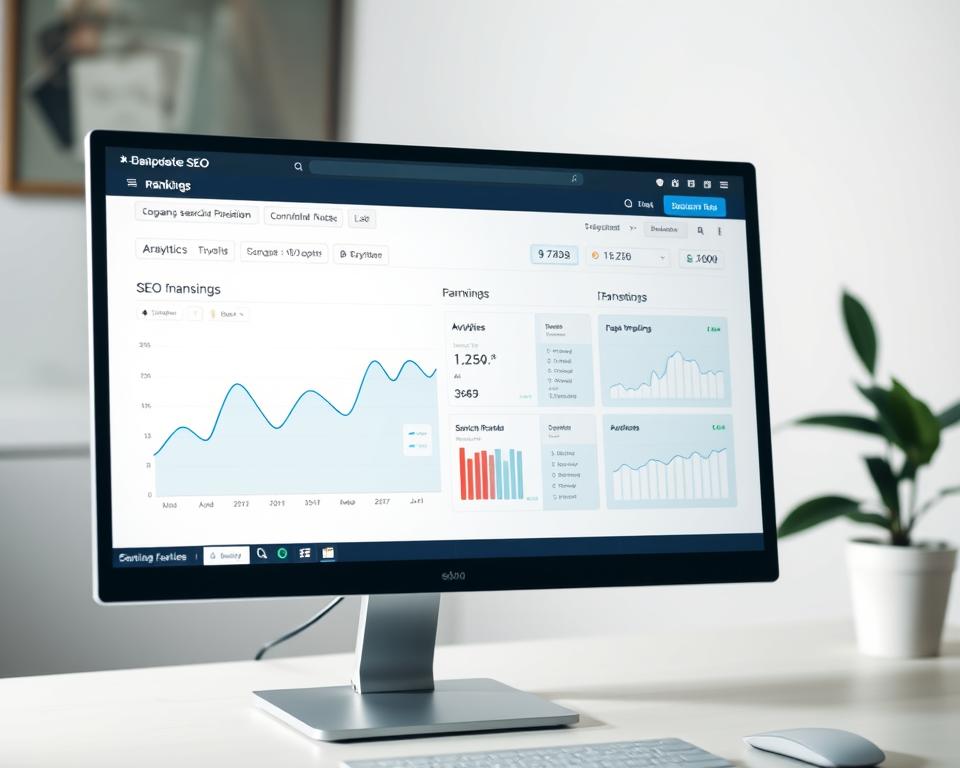Digital Marketing Excellence: Mastering 1on1 SEO in Indianapolis
The Indianapolis Expert Digital Marketing and SEO Services
Would you believe that enterprises putting resources into SEO can experience up to a 664% boost in natural visitor growth. In Indianapolis, the demand for efficient Digital Marketing SEO strategies is expanding swiftly. Businesses strive to enhance their internet visibility and communicate more clearly with their audience. Our demonstrated performance proves we can raise online leads by over a 360% surge and natural income by an average of 86.65%.
As a top-rated Indianapolis SEO agency, we understand the intricacies of cyber marketing and SEO’s essential function. Our over 15 years of expertise empower us to offer customized solutions for Indianapolis companies. This write-up will explore the diverse Digital Marketing SEO approaches in Indianapolis. It will show how these tools and strategies can rapidly enhance your company’s internet performance with SEO Indianapolis.
Comprehending the Value of SEO in Indianapolis
Search Engine Optimization (SEO) is crucial in Indianapolis’s digital world. It enables companies to distinguish themselves and increases their internet visibility. With the growing trend of online service searches, a powerful SEO approach is essential for drawing local clients and cultivating leads.
Defining SEO and Its Importance
SEO optimizes websites for better search engine rankings. In Indianapolis’s cutthroat arena, a solid internet visibility is essential. By perfecting Google Business Profiles, companies can appear in regional search results and on Google Maps. This elevates site visits, using geo-targeted phrases like “best SEO services in Indianapolis.”
Internal features like page titles, meta summaries, and header elements are crucial. They help improve search rankings, making certain that users can access the website.
The Role of SEO in Driving Growth
Robust SEO methods propel enterprise development. A mobile-friendly website engages smartphone users, who lead online searches. Regionally targeted content enhances market credibility, improving search rankings and visibility.
Networks boost brand recognition, generate site visits, and improve client interaction. These elements are crucial for improved rankings. Indianapolis SEO experts leverage sophisticated metrics to enhance tactics continuously. Bespoke SEO strategies target sustainable growth, adhering to ethical standards to improve metrics.
Digital Marketing SEO in Indianapolis: Enhancing Your Digital Footprint
Embracing Digital Marketing SEO requires a multi-faceted approach, blending various online marketing strategies. A online marketing expert in Indianapolis can guide enterprises to maximize the benefits of these methods. This includes content marketing, social media optimization, and email marketing. It’s vital to grasp how to apply Digital Marketing SEO to amplify your digital reach and connect with your intended audience.
Understanding Digital Marketing SEO
Digital Marketing SEO centers on refining your digital footprint to secure better search placements and interact with visitors. It comprises keyword refinement, enhancing user interface and experience, and developing quality material. This strategy lures unpaid traffic and improves conversion metrics, laying the groundwork for successful campaigns.
Tactics for Successful Digital Marketing in Indianapolis
- SEO Audits: Perform comprehensive evaluations to uncover ways to enhance ranking and exposure.
- Keyword Research: Uncover influential search terms that connect with your intended audience, propelling unpaid traffic.
- UX Design and Development: Create user-friendly websites that boost both user experience and search engine performance.
- Content Creation & Content Marketing: Develop high-quality, keyword-optimized content to attract and convert users.
- Link Building: Secure reputable inbound links to boost ranking and build site credibility.
- Local SEO Services: Enhance Google My Business entries and apply local link-building methods to elevate neighborhood visibility.
Leveraging data analysis provides clarity for smart decision-making, keeping your marketing tactics potent. Compelling material coupled with vibrant social media activity broadens reach and intensifies consumer involvement. Collaborating with an Indianapolis digital marketing firm streamlines these processes, offering the proficiency required to master the competitive market.
Effective SEO Services in Indianapolis
The SEO landscape is in a state of flux, making it imperative for Indianapolis companies to leverage efficient strategies to improve their internet visibility. Collaborating with the foremost SEO agency in Indianapolis offers a range of SEO services tailored to each business’s needs. Key elements are essential for successful SEO campaigns.

Identifying and Analyzing Keywords
Keyword research is the cornerstone of any effective SEO strategy. It helps businesses attract the right audience by discovering high-impact search terms. The best SEO company in Indianapolis uses advanced tools to study search behavior. This helps pinpoint keywords with high search volumes and aligns with user intent.
This detailed analysis boosts visibility in search engine results and increases engagement.
Internal and External SEO Strategies
On-page SEO refines each webpage to boost search positions and usability. It involves refining content, title tags, and meta descriptions for relevance and clarity. Off-page SEO, by contrast, focuses on building a strong backlink profile through link building and social media engagement.
A fusion of on-page and off-page strategies greatly boosts site prominence and draws in premium traffic.
Technical Optimization for Superior Functionality
Technical SEO is essential for ensuring websites operate efficiently and offer a great user experience. It covers enhancing load times, bolstering mobile-friendliness, and maintaining secure connections. These elements render a site more attractive to search algorithms, resulting in improved rankings.
Frequent reviews and enhancements are required to sustain peak performance and comply with standards. This ensures continued achievement in search performance.
Reasons to Partner with Marketing1on1 for Indianapolis SEO
Marketing1on1 is a leading option for an Indianapolis SEO agency, featuring a robust record of success in diverse fields. Their success is reflected in glowing client feedback and award-winning campaigns. Businesses looking to boost their online visibility can tap into the agency’s deep experience. Their team uses advanced tools and strategies to achieve top results.
Demonstrated Success and Knowledge
As a experienced SEO expert in Indianapolis, Marketing1on1 employs analytics-based methods to optimize returns for clients. They meticulously assess SEO requirements through keyword research, competitor analysis, and website performance checks. Tools like Google Search Console and SEMRush are employed to gauge website health, providing vital insights for strategic planning.
Customized SEO Approaches for Unique Needs
This Indianapolis SEO agency crafts bespoke SEO strategies, tailored to each business’s unique needs. They set measurable goals, such as securing top keyword rankings within a set timeframe. By prioritizing superior material adhering to E-E-A-T principles—Expertise, Experience, Authority, Trust, Marketing1on1 enhances site prominence on search platforms.
| Feature | Details |
|---|---|
| Metric-Based Review | Uses advanced platforms such as Google Search Console and SEMRush for comprehensive analysis. |
| Tailored Plans | Crafts personalized plans aligned with industry needs and individual targets. |
| All-Inclusive Offerings | Encompasses diverse services including social platforms, paid advertising, and content creation. |
| Open Dialogue | Regular updates and automated reporting through tools like AgencyAnalytics. |
| Technical SEO Audits | Addresses issues like site speed and broken links for improved performance. |
Local SEO Solutions for Indianapolis Businesses
Local SEO is a crucial part of online promotion for Indianapolis businesses. It’s critical because 56% of businesses haven’t claimed their Google My Business listings. Securing and enhancing these profiles significantly boosts regional visibility. Customized regional SEO approaches draw high-quality visitors and drive more in-store traffic.
Why Local Search Matters in Online Marketing
Mobile users increasingly rely on smartphones to find local services. This makes mobile-friendly sites crucial. In fact, 61% of mobile visitors favor contacting businesses that are mobile-optimized. Verifying consistent NAP information across sites like Google Maps and Yelp increases regional exposure. Emphasizing customer feedback elevates trust and improves local rankings, key for community prosperity.
Local SEO Strategies to Outsmart Competitors
Implementing strategic tactics can give Indianapolis businesses a competitive edge. Key strategies include:
- Optimizing Google My Business listings to improve local search visibility.
- Incorporating location-specific search terms tailored for Indianapolis.
- Developing area-specific content such as local guides or top lists to drive regional visitors.
- Conducting thorough local SEO audits to identify areas for improvement.
- Building high-quality backlinks from local authority sites to enhance rankings.
- Keeping NAP information consistent across multiple digital listings.
Creating location-specific landing pages and content that reflects local search intent can also boost search performance. Continuous optimization of business profiles and diligent reputation management reinforce regional visibility. By using these local SEO strategies, companies can attract high-intent customers in Indianapolis’s diverse neighborhoods.
The Importance of Content Marketing in Achieving SEO Goals
Content marketing is vital for enhancing search performance. It helps businesses draw in and engage their target audience, cultivating trust and generating income. Effective strategies enhance trust and credibility, leading to stronger customer ties and higher sales.
Creating High-Quality, SEO-Friendly Content
Creating valuable content demands a strategic mindset. It’s vital to create compelling and instructive content tailored for your market. Superior material addresses target demands, thereby improving search performance. Captivating material keeps users engaged while simultaneously elevating search rankings through reduced bounce and extended site duration.
Leveraging Blogging for Increased Traffic
Blogging is a top content marketing tactic for boosting organic traffic. Consistent blogging delivers insights, captivates readers, and motivates buying decisions. By integrating blog marketing with performance metrics, enterprises can measure success and tweak their approach, businesses can track performance and refine their strategies.
| Material Format | Objective | Benefits |
|---|---|---|
| Written Content | Educate and captivate | Increase site visits and elevate ranking positions |
| Visual Content | Explain and captivate | Increase user engagement |
| Visual Data | Visual information | Easily distributable, broad impact |
| Webinars | Detailed education | Drive prospects and build credibility |
In Indianapolis, successful content initiatives require avoiding poor-quality output and insufficient planning. Regular review and tactical updates ensure sustained online success.
Monitoring and Analyzing SEO Performance
For Indianapolis businesses, monitoring and analyzing SEO performance is essential. Essential indicators track the success of approaches such as organic traffic growth, keyword rankings, conversion rates, and ROI are imperative. A trusted Indianapolis SEO agency can enhance these metrics.
Critical Metrics to Gauge SEO Impact
Success in SEO depends on monitoring several vital indicators. These include:
- Organic Traffic Growth: A notable increase (664%) in organic traffic demonstrates successful tactics.
- Keyword Rankings: Observing keyword placement aids in targeting valuable search terms.
- Conversion Rate: An improvement (640%) in conversion rates demonstrates effective audience capture.
- Online Leads: Online leads can surge by 800%, highlighting SEO’s power.
Instruments to Measure SEO Success
Various instruments are available for monitoring search optimization. Google Analytics delivers comprehensive data on visitor actions. SEMrush is essential for examining competitor strategies and link structures, key for local SEO. Frequent updates provide clarity for tactical refinements. Each partner receives individualized support from a project specialist.
Future Trends in Digital Marketing SEO
The Digital Marketing SEO environment is constantly changing, driven by advanced tech and evolving market patterns. Businesses in Indianapolis must stay ahead by adapting to these trends. Monitoring Indianapolis’s SEO trends is essential for effective planning.
Innovative Technologies Shaping SEO
Several modern innovations are poised to transform online marketing approaches. AI-driven search technologies will lead the way, demanding high-quality content and better semantic search optimization. With the increase in zero-click queries, enhancing content for featured snippets and local packs is imperative.
- By 2025, voice queries may account for over 50% of searches, necessitating conversational language and extended key phrases.
- Augmented reality and visual search will grow in importance, meaning a focus on high-quality visuals and descriptive alt text to improve user experience.
- Mobile optimization will remain essential, focusing on site speed, user experience, and Core Web Vitals.
- Marketing content will evolve into more individualized and interactive forms such as quizzes and dynamic videos.
Keeping Current with Search Engine Updates
Staying informed about algorithm changes is vital. Trust and transparency are now key, with a focus on well-researched content and secure HTTPS sites. AI and automation tools will transform digital marketing in Indianapolis, with chatbots, predictive analytics, and personalized content playing major roles.
- Optimizing for voice search will gain significance, demanding natural language on responsive sites.
- Video marketing, including short-form content and shoppable videos, will be essential for engaging audiences.
- Platforms such as Instagram and TikTok will further fuel social selling and influencer-led engagement.
- Emphasis on data protection and moral marketing will drive companies to adopt clear practices and first-party data methods.
As a Final Point
In Indianapolis’s dynamic arena, Digital Marketing SEO services are vital for enterprises looking to improve internet visibility and scale. With over 92% of online activities starting with a search engine, the value of effective SEO cannot be overstated. Area-specific optimization is crucial, with 76% of local queries indicating purchase intent to capture the ideal market.
Partnering with trusted providers like Marketing1on1 offers customized SEO services for Indianapolis’s unique market. Their more than 15 years of expertise produce tangible outcomes, like a 34X lead boost for Dentcore. As Indianapolis thrives on technological advancement, these strategies offer substantial benefits for improving presence and growth.
Working with a professional agency to navigate digital marketing and SEO can set businesses on the right track.
They deliver tailored strategies combined with in-depth regional expertise, which drive enhanced visibility, more prospects, and superior conversion rates. The impact of effective SEO and the chance to work with agencies focused on results tailored to your goals are significant.
FAQ
Can you explain SEO and its advantages for Indianapolis businesses?
SEO, or Search Engine Optimization, enhances the prominence of a website on search platforms. For Indianapolis companies, effective SEO can draw in the right traffic. This can boost income, fostering expansion and stability amid competition.
Which key SEO services are available in Indianapolis?
Key SEO services in Indianapolis include keyword research, on-page and off-page SEO, and technical SEO. These services are designed to enhance content, improve website speed, and guarantee mobile responsiveness. The aim is to optimize user interaction and elevate search performance.
What makes local SEO crucial for companies in Indianapolis?
Local SEO is vital for companies targeting local consumers. It captures local traffic through optimized Google My Business listings, geo-targeted keywords, and customer reviews. This improves search prominence and drives physical traffic for local enterprises.
How can content marketing influence SEO success?
Content marketing is crucial for boosting SEO efforts. It involves creating high-quality, SEO-friendly content that appeals to the target audience. Engaging and informative content drives organic traffic and enhances user engagement, leading to better SEO rankings.
What performance metrics are critical for assessing SEO?
To assess the impact of SEO, track organic traffic, bounce rates, keyword rankings, and conversion rates. Analytics tools like Google Analytics and SEMrush offer insights into user behavior and website performance. This insights facilitate strategic modifications.
What trends should Indianapolis businesses be aware of in digital marketing SEO?
Businesses should keep an eye on emerging technologies like artificial intelligence, voice search, and blockchain’s impact on SEO. Keeping pace with algorithm updates is vital to ensure a competitive edge in the digital world.
Why should one select Marketing1on1 for SEO in Indianapolis?
Marketing1on1 has earned a reputation as a leading SEO provider in Indianapolis. It features a history of success and tailored approaches. They customize their SEO tactics to match individual objectives, delivering results across different sectors and audiences.









